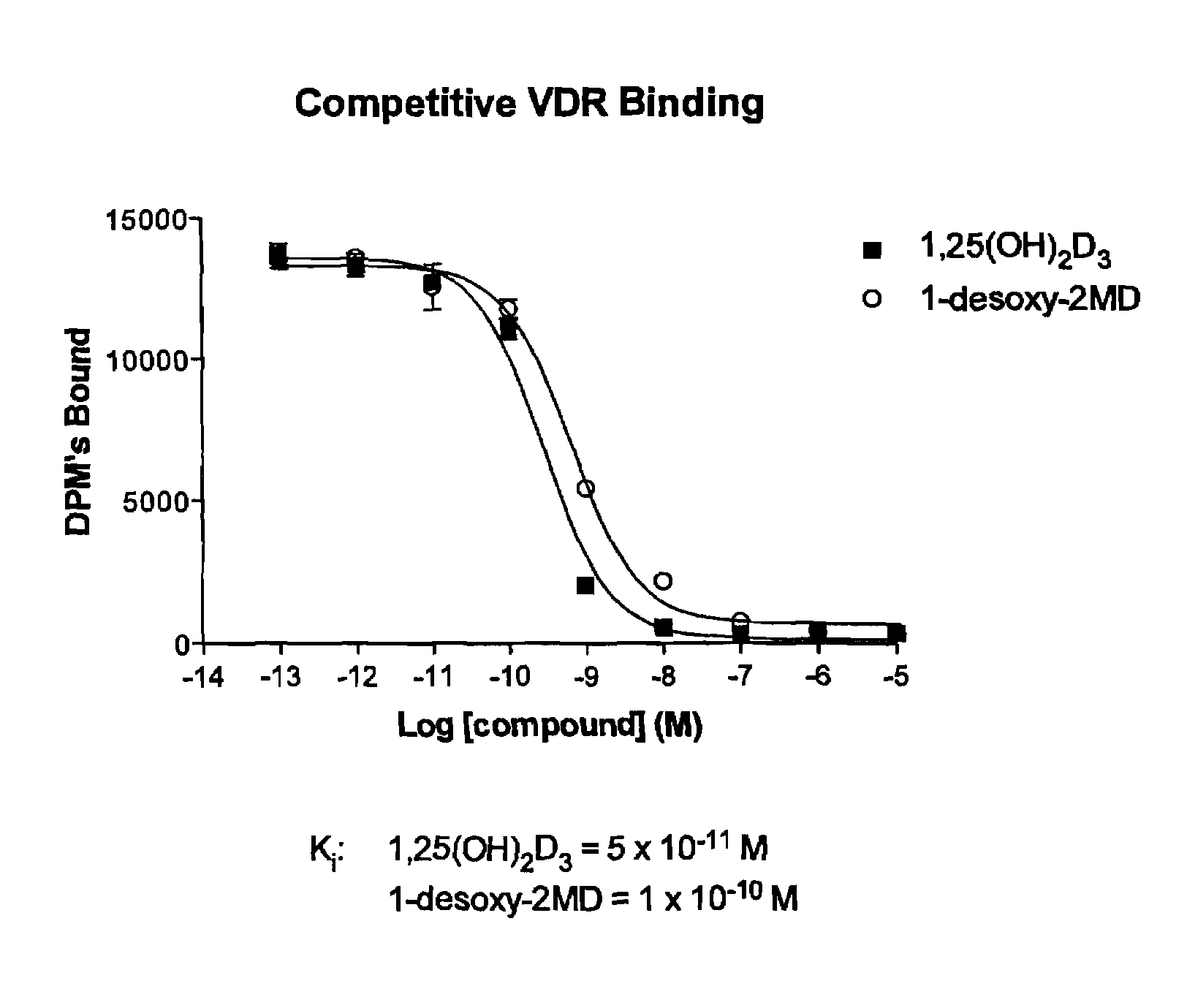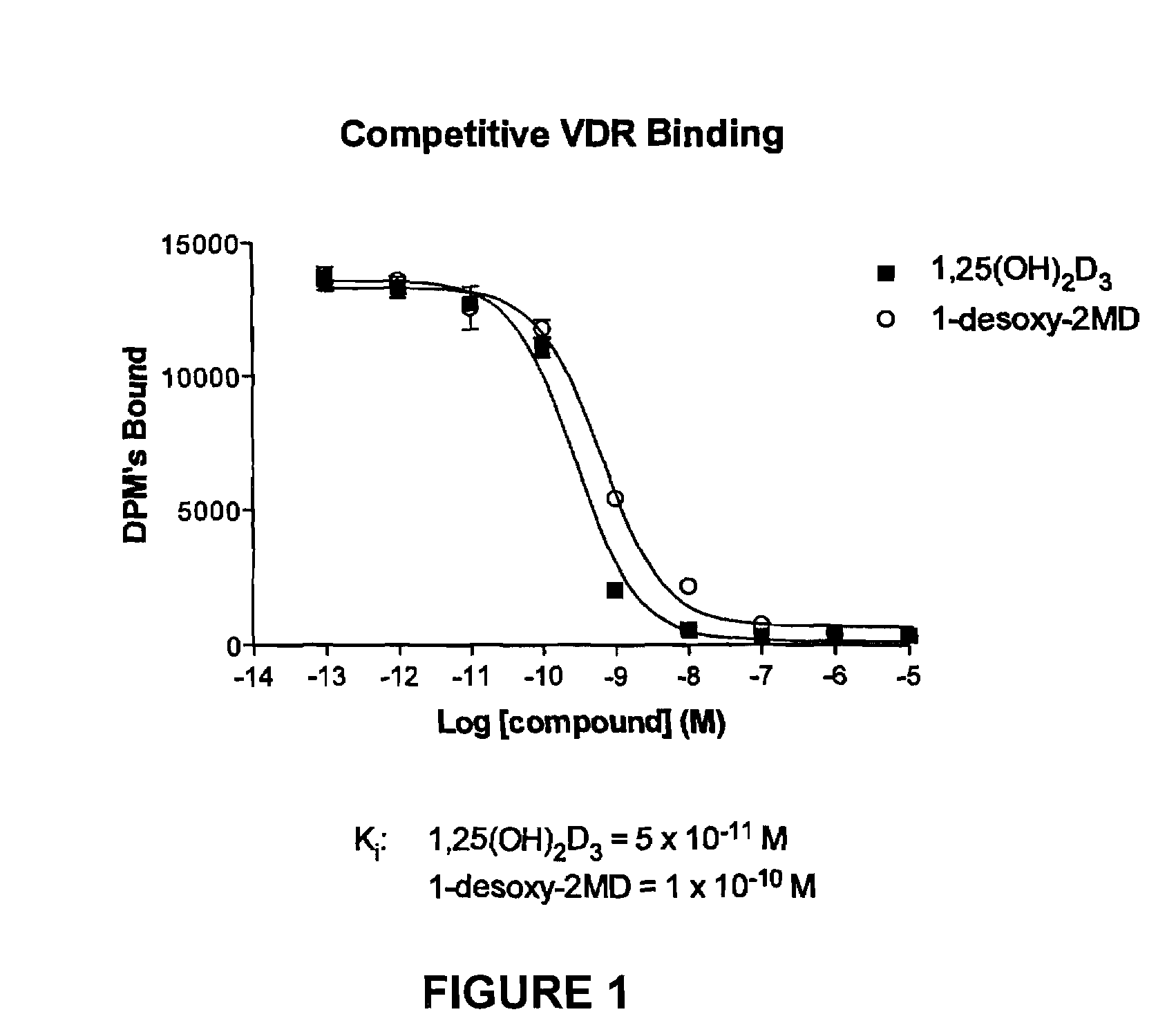1-desoxy-2-methylene-19-nor-vitamin D analogs and their uses
a technology of sodium methylene and sodium methylene, which is applied in the field of vitamin d compounds, can solve the problems of cyclohexanediol ring flattening, and achieve the effects of low transcriptional activity, low affinity, and high binding to vitamin d receptors
- Summary
- Abstract
- Description
- Claims
- Application Information
AI Technical Summary
Problems solved by technology
Method used
Image
Examples
examples
[0038]Chemistry. Melting points (uncorrected) were determined on a Thomas-Hoover capillary melting-point apparatus. Optical rotations were measured in chloroform using a Perkin-Elmer 241 automatic polarimeter at 22° C. Ultraviolet (UV) absorption spectra were recorded with a Perkin-Elmer Lambda 3B UV-VIS spectrophotometer in ethanol. 1H nuclear magnetic resonance (NMR) spectra were recorded in deuteriochloroform at 200, 400 and 500 MHz with a Varian Unity, Bruker DMX-400 and Bruker DMX-500 spectrometers, respectively. 13C nuclear magnetic resonance (NMR) spectra were recorded at 50, 100 and 125 MHz with the same spectrometers in deuteriochloroform. Chemical shifts (δ) were reported downfield from internal Me4Si (δ 0.00). Electron impact (EI) mass spectra were obtained with a Micromass AutoSpec (Beverly, Mass.) instrument. High-performance liquid chromatography (HPLC) was performed on a Waters Associates liquid chromatograph equipped with a Model 6000A solvent delivery system, a Mode...
example i
Preparation of (20S)-2-methylene-25-hydroxy-19-nor-vitamin D3 (12, 1-desoxy-2MD) from the phosphine oxide 10
[0039](a) α-Hydroxylation of a ketal-ketone 1 (SCHEME I). (R)-7-Hydroxy-1,4-dioxa-spiro[4.5]decan-8-one (2). To a stirred solution of 1,4-cyclohexanedione monoethylene ketal (1; 3.00 g, 19.23 mmol) and L-proline (0.97 g, 8.42 mmol) in CHCl3 (10 mL), a solution of nitrosobenzene (3.60 g, 33.65 mmol) in CHCl3 (16 mL) was slowly added at 4° C. over 24 h by a syringe pump. Then the mixture was stirred at room temperature for additional 2 h. Reaction was quenched with brine, and the organic materials were extracted with ethyl acetate, dried (MgSO4) and concentrated in vacuum. Purification by column chromatography on silica (0.5→20% ethyl acetate / hexane gradient) gave an oily α-hydroxy ketone 2 (1.45 g, 44%). Purity of the product was checked by HPLC (4.6 mm×25 cm Chiralcell OD-H column, 1.5 mL / min) using hexane / 2-propanol (99:1) solvent system: it was found to have enantiomeric exc...
example ii
[0057]Preparation of (20S)-2-methylene-25-hydroxy-19-nor-vitamin D3 (12, 1-desoxy-2MD) from the phosphine oxide 27.
[0058](a) Lactonization of the quinic acid 13 (SCHEME II). (1S,3R,4R,5R)-1,3,4-Trihydroxy-6-oxa-bicyclo[3.2.1]octan-7-one (14). A solution of D-(−)-quinic acid (20.0 g, 104 mmol) and p-toluenesulfonic acid (2.2 g, 11.6 mmol) in anhydrous toluene (200 mL) and anhydrous DMF (75 mL) was refluxed under Dean-Stark trap for 34 h. The reaction mixture was cooled to 23° C. and concentrated under reduced pressure to afford a thick yellow oil. It was diluted with methylene chloride (100 mL), hexane (200 mL) was added and the resulting mixture was set aside at 23° C. for 12 h. The precipitated product was collected by vacuum filtration, and it was further dried in vacuo to afford the lactone 14 (13.0 g, 72%) as a white powder (mp 184-188° C., lit. mp 184-185° C.).
[0059]14: 1H NMR (500 MHz, CD3OD) δ 1.87 (1H, br t, J˜11 Hz, 2α-H), 2.02 (1H, ddd, J=11.7, 6.5, 2.9 Hz, 2β-H), 2.22 (1H...
PUM
| Property | Measurement | Unit |
|---|---|---|
| enantiomeric excess | aaaaa | aaaaa |
| temperature | aaaaa | aaaaa |
| temperature | aaaaa | aaaaa |
Abstract
Description
Claims
Application Information
 Login to View More
Login to View More - R&D
- Intellectual Property
- Life Sciences
- Materials
- Tech Scout
- Unparalleled Data Quality
- Higher Quality Content
- 60% Fewer Hallucinations
Browse by: Latest US Patents, China's latest patents, Technical Efficacy Thesaurus, Application Domain, Technology Topic, Popular Technical Reports.
© 2025 PatSnap. All rights reserved.Legal|Privacy policy|Modern Slavery Act Transparency Statement|Sitemap|About US| Contact US: help@patsnap.com



